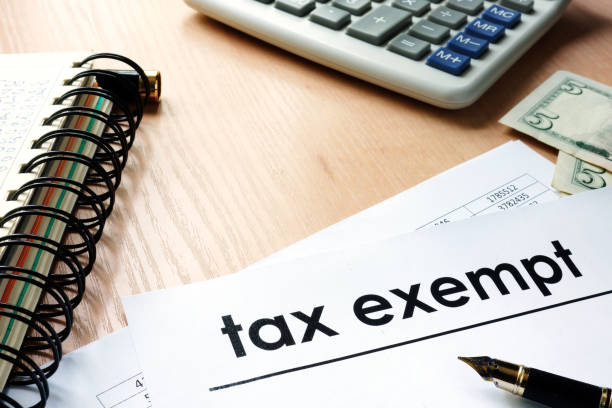This article may contain references to products or services from one or more of our advertisers or partners. We may receive compensation when you click on links to those products or services. Nonetheless, our opinions are our own.
The information presented in this article is accurate to the best of our knowledge at the time of publication. However, information is subject to change, and no guarantees are made about the continued accuracy or completeness of this content after its publication date.
Key Highlights
- A tax-exempt status allows groups to avoid paying federal income tax and get other benefits.
- 501(c)(3) status is the primary type of classification for nonprofits under tax law.
- To qualify for this tax break, groups must meet specific requirements. This includes having charitable goals and good management.
- The application steps involve completing IRS Form 1023 and obtaining a tax identification number (EIN).
- To maintain a tax-exempt status, it is essential to comply with the rules at all levels of government.
- Groups must operate only for these exempt purposes to avoid fines.
Introduction
Tax-exempt status is crucial for organizations that aim to minimize their tax burden while supporting charitable causes. If you are starting a nonprofit or applying for this status, the Internal Revenue Service (IRS) outlines the steps you need to take. Achieving this status can alleviate your financial stress and foster trust with others. This guide will help you learn the main steps to get tax-exempt status for your nonprofit.
Understanding Tax-Exempt Status
Tax-exempt status allows some groups not to pay federal income tax if they work for charity, as defined by the IRS. These reasons can include education, religion, public safety, and more.
Once they are approved, organizations can receive tax-deductible donations. This makes them more attractive to supporters. The application process can be detailed, but the rewards include access to more funding options and enhanced long-term support.
What Is Tax Exemption?
Tax exemption means that some nonprofit organizations are exempt from paying federal income tax on the money they earn from their activities. To achieve this, an organization must comply with IRS rules. These rules are usually found in Section 501(c)(3) of the Internal Revenue Code.
Groups that can qualify include nonprofit organizations, trusts, community groups, and unincorporated associations. These groups work for the benefit of the public.
This label helps groups save more money for their important work, rather than paying it in taxes. However, it is essential to follow the rules. Nonprofits must adhere to strict guidelines regarding the management of their work. They need to remain neutral in politics and manage their finances wisely to maintain their status and trust.
Voted "Best Overall Budgeting App" by Forbes and WSJ
Monarch Money helps you budget, track spending, set goals, and plan your financial future—all in one app.
Get 50% OFF your first year with code MONARCHVIP
Why Tax-Exempt Status Matters
Nonprofits strive to help people, and not paying taxes saves them money while also building trust within the community. This enables them to utilize more resources for their work and garner public support through tax-deductible donations.
Whether you run a church, a school, or a charity, being free from taxes can help you raise money and support growth over time. It also allows for local and state tax breaks, such as property and sales tax relief, which can enhance your financial well-being.
Following IRS rules helps groups avoid fines. It also keeps their goals clear.
Preparing to Apply for Tax-Exempt Status
Before applying, organizations must take specific steps to qualify. This involves gathering the necessary documents, clearly describing their charitable goals, and implementing effective management practices.
Careful planning can lower mistakes in the application process. It also boosts your chances of getting approved. Being clear and following the rules from the start builds a strong foundation for your organization’s future.
Essential Documents and Information Needed
To get tax-exempt status, a group needs to do these things:
- Incorporation documents that clearly show a charitable goal
- Financial records, including planned budgets and total income
- Management documents like guidelines and a conflict of interest plan
These documents need to meet the IRS’s standards. The articles should demonstrate a purpose, such as supporting education or the community. Financial records reveal that the group is operating effectively, and internal rules indicate sound management.
Keeping accurate and complete records is crucial. Errors or unclear words can delay approvals or lead to rejection.
Determining Your Eligibility
Eligibility is based on strict IRS rules. Your organization needs to have clear goals, like promoting education, religion, or social welfare. It must also be legally established as a nonprofit entity, such as a nonprofit corporation or trust.
The IRS checks if the organization serves private interests or is involved in politics. If it does, they might reject the application.
Good governance, adhering to your mission, and having a robust legal framework are all crucial. Building a solid legal and operational foundation increases your chances of securing and maintaining your status.
Step-by-Step Guide to Getting Tax-Free Status
Step 1: Incorporate Your Organization
Start by sending your Articles of Incorporation to your state’s business office. These papers must include your organization’s name, the reason for being a charity, and a note about what will happen to its property if the organization closes down.
You need to pick a board of directors. It’s good to have mostly independent members to meet IRS rules.
Incorporating correctly isn’t just a legal requirement. It is also essential for filing IRS Form 1023.
Step 2: Obtain an Identification Number (EIN)
Your Employer Identification Number (EIN) is a unique number assigned by the IRS. You need it for taxes, banking, and legal papers. You can get an EIN by applying online at the IRS website.
This step helps to make your organization a legal business. It is essential to complete this step before beginning the Form 1023 application.
Step 3: Complete and Submit IRS Form 1023
IRS Form 1023 is the form you need to apply for tax-exempt status. It asks for details about your group’s goals, actions, budget, and management.
Smaller organizations that generate less revenue and have fewer resources can submit Form 1023-EZ. This is a simplified version of the entire application.
Once you have finished, please send the form online along with the fee. If it is approved, the IRS will send a letter. This letter confirms that you are exempt from paying taxes. It is an essential document for requesting donations and adhering to the rules.
Conclusion
Obtaining tax-exempt status is a key goal that can help your organization thrive and operate effectively. By learning the application steps and preparing well, you can raise your chances of getting approved and avoid unnecessary delays.
Clear goals, accurate records, and adherence to rules are key to lasting success. If you are starting a new nonprofit or making an existing one official, obtaining tax-exempt status can help you grow your mission and secure necessary support.
Frequently Asked Questions
What are the present rules that tax-free organizations need to follow?
Tax-exempt groups are required to file annual returns, such as Form 990 or 990-EZ. They need to ensure that all their activities help their mission. It is also essential to stay informed about IRS rule changes and maintain good governance practices.
What activities could put our tax-free status in danger?
Joining political campaigns, working for your benefit, or making a lot of money from unrelated businesses can risk your tax-exempt status. It is essential to keep your work aligned with your charitable goals. Avoid activities that do not follow nonprofit rules.
Can a group that doesn’t have to pay taxes participate in fundraising?
Yes, fundraising is permitted and often crucial for nonprofit work. However, all fundraising efforts must align with the organization’s primary objective. It also needs to comply with the laws at both the federal and state levels regarding how to request funds.
How long does it take to get tax-free status after applying?
Approval times can vary, but the IRS typically reviews Form 1023 within 3 to 12 months. If you submit complete and accurate forms, it can help reduce your wait time. Once approved, the IRS will mail you a letter detailing your status.

Reviewed and edited by Albert Fang.
See a typo or want to suggest an edit/revision to the content? Use the contact us form to provide feedback.
At FangWallet, we value editorial integrity and open collaboration in curating quality content for readers to enjoy. Much appreciated for the assist.
Did you like our article and find it insightful? We encourage sharing the article link with family and friends to benefit as well - better yet, sharing on social media. Thank you for the support! 🍉
Article Title: How to Apply for Tax Exempt Status
https://fangwallet.com/2025/04/20/tax-exempt-status/The FangWallet Promise
FangWallet is an editorially independent resource - founded on breaking down challenging financial concepts for anyone to understand since 2014. While we adhere to editorial integrity, note that this post may contain references to products from our partners.
The FangWallet promise is always to have your best interest in mind and be transparent and honest about the financial picture.
Become an Insider

Subscribe to get a free daily budget planner printable to help get your money on track!
Make passive money the right way. No spam.
Editorial Disclaimer: The editorial content on this page is not provided by any of the companies mentioned. The opinions expressed here are the author's alone.
The content of this website is for informational purposes only and does not represent investment advice, or an offer or solicitation to buy or sell any security, investment, or product. Investors are encouraged to do their own due diligence, and, if necessary, consult professional advising before making any investment decisions. Investing involves a high degree of risk, and financial losses may occur including the potential loss of principal.
Source Citation References:
+ Inspo
There are no additional citations or references to note for this article at this time.












































